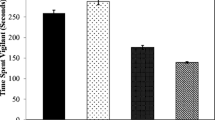Summary
Species of the genus Gerbillus are very common among the rodent fauna inhabiting arid zones and dune habitats in the palaearctic region. In Israel G. nanus is distributed in extreme arid areas, while G. allenbyi is common in coastal plain dune habitats, of mesic and semi-arid areas. Therefore, their distribution pattern is considered allopatric.
Heat production, estimated by the oxygen consumption (Vo2), and body temperature (T b) at various ambient temperatures were measured in both gerbils. The thermoneutral zone for G. allenbyi is between T a=28–35° C (\(\dot V_{{\text{O}}_{\text{2}} } \) T b=36.3–38.3° C) and for G. nanus is at T a=33±1° C (\(\dot V_{{\text{O}}_{\text{2}} } \), T b=38.8° C). The \(\dot V_{{\text{O}}_{\text{2}} } \) values at thermoneutrality are 75.7% and 50.6% respectively of the calculated values for rodents with a mean body weight of 35.3 g and 28.4 g.
Nonshivering thermogenesis (NST) was measured in both species as the maximal response to an injection of noradrenaline (2.0 mg/Kg s.c.). NST magnitude was the same for both species.
The results show that both gerbils are adapted to arid environments. The difference in the thermoneutral zones of the two species is discussed in terms of its adaptive nature.
Similar content being viewed by others
References
Atlas of Israel (1970) Surveys of Israel Ministry of Labour. Elsevier, Amsterdam, Jerusalem
Borut A, Shkolnik A (1974) Physiological adaptations to the desert environment. In: Robertshaw D (ed) MTP international review of science, physiology, ser 1, Vol 7 (Environmental Physiology). Butterworths, London, pp 185–229
Borut A, Haim A, Castel M (1978) Non-shivering thermogenesis and implications of the thyroid in cold labial and cold resistant populations of the golden spiny mouse Acomys russatus. In: Girardier L, Seydoux J (eds) Effectors of thermogenesis. Experientia suppl 32. Birkhauser, Basel, pp 219–227
Brody S (1945) Bioenergetics and growth. Reinhold Public Corp, New York, p 1023
Dawson WR (1955) The relation of oxygen consumption to temperature in desert rodents. J Mammal 36:543–552
Depocas F, hart JS (1957) Use of the Pauling oxygen analyzer for measurements of oxygen consumption of animals in open circuit system and in short lag, closed circuit apparatus. J Appl Physiol 20:388–392
Goyal SP, Ghosh PK, Prakash I (1982) Energetic aspects of adaptation in the Indian desert gerbil Meriones hurrianae Jerdon. J of arid Environ 5:69–75
Haim A, Borut A (1976) Thermoregulation and non-shivering thermogenesis as factors limiting distribution of the golden spiny mouse (Acomys russatus). Isr J Med Sci 12:896
Haim A, Fourie le FR (1980) Heat production in nocturnal (Praomys natalensis) and diurnal (Rhabdomys pumilio) South African murids. S Afr J Zool 15:91–94
Haim A, Borut A (1981) Heat production and dissipation in golden spiny mice, Acomys russatus from two extreme habitats. J Comp Physiol 142:445–450
Harrison DL (1972) The mammals of Arabia, Vol. III. Benn, London
Hart JS (1971) Rodents. In: Whittow CG (ed) Comparative physiology of thermoregulation, Vol. II. Academic Press, New York, pp 1–149
Heldmaier G (1971) Zitterfreie Wärmebildung und Körpergrösse bei Säugetieren. Z Vergl Physiol 73:222–248
Hill RW (1972) Determination of oxygen consumption by use of the paramagnetic oxygen analyzer. J Appl Physiol 33:261–263
Hudson JW, Wang LCH (1969) Thyroid function in desert ground squirrels. In: Haft CC, Riedesel MK (eds) Physiological systems in semiarid environments. University of New Mexico, Albuquerque
Jansky L (1973) Non-shivering thermogenesis and its thermoregulatory significance. Biol Rev 48:85–132
MacMillen RE, Lee AK (1970) Energy metabolism and pulmocutaneous water loss of Australian hopping mice. Comp Biochem Physiol 35:355–369
Ritte U, Haim A, Neufeld E (2976) Use of electrophoretic patterns of hemoglobin for identification of Israeli gerbils (Genus Gerbillus: Rodentia: Gerbillinae). Isr J Zool 25:52–60
Robinson PR, Henrickson RV (1961) Metabolism of Gerbillus pyramidum. Nature 190:637–638
Scholander PF, Hock R, Walters V, Johnson F, Irving L (1950a) Heat regulation in some arctic and tropical mammals and birds. Biol Bull 99:237–258
Scholander PF, Hock R, Walters V, Irving L (1950b) Adaptations to cold in aretic and tropic mammals and birds in relation to body temperature, insulation, and basal metabolic rate. Biol Bul 99:259–271
Webster AJF (1974) Adaptation to cold. In: Robertshaw D (ed) MTP international review of science, Physiology, ser. 1, Vol. 7 (Environmental Physiology), Butterworths, London, pp 71–107
Yousef MK, Johnson HD (1975) Thyroid activity in desert rodents: A mechanism for lower metabolic rate. Am J Physiol 229:727–731
Zahavi A, Wahrman J (1957) The cytotaxonomy, ecology and evolution of the gerbils and jirds of Israel (Rodentia: Gerbillinae). Mammalia 21:341–380
Author information
Authors and Affiliations
Rights and permissions
About this article
Cite this article
Haim, A. Adaptive variations in heat production within Gerbils (genus Gerbillus) from different habitats. Oecologia 61, 49–52 (1984). https://doi.org/10.1007/BF00379087
Received:
Issue Date:
DOI: https://doi.org/10.1007/BF00379087




